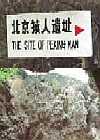 Fig.1. 37°C at Zhoukoudian |
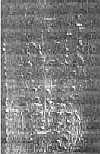 Fig.2.Marshak lunar calendar |
A Cosmic Origin for Patriarchy ? Summary At NEWS 95, I suggested that the shift from bronze Age to iron Age required the discovery of "causality", and that this very first scientific concept is bound to the recent, 5.000 years old, acknowledgement of the role of paternity in procreation. The discovery by Louis A. Frank of small ice comets storms comforts now an exciting new scenario for the emergence of patriarchy: the appropriation of time and space as corollary to the observation of the solar orb ! Intellectual resources invested in attempts to match the lunar cycle (which, since the darkness of the ages triggers nothing less than the human female menstrual cycles) to the solar cycle are tantamount. They might therefore be rated as the price to pay for the mind-blowing paradigmatic shift from matrifocal to patriarchal form of social organisation. Sheer negation is of course another approach to "conciliate" those antagonistic paradigms. The denying of the role of paternity in procreation is now the exception at the societal level, but, it still is surprisingly common at the individual level, and, well anchored as founding myth, as "dogma" of otherwise patriarchal religions, such as the Islam or the Roman Catholic ones. Diffuse vs. Direct Day-Light Recently, after the visit of one of the cradles of our humanity (Fig.1), I emerged out of the cave. The sky over Zhoukoudian was bright, white, sealed. The solar orb was not visible and therefore did not provide its most convenient time of the day position. The "green house" air temperature was 37°C, utterly "uterine". Time of the day at this half a million years old site seemed absent, out of place and time. I appreciated how much, over the last two hundred fifty generations, homo sapiens got accustomed to see the sun accomplishing daily its path over his head, and how deeply shocking to his rational mind would be the mere possibility of "His Earth" being surrounded by a high altitude cocoon of clouds making the solar orb invisible.… Fortunately, "My GPS", on finger touch, provided Me, thanks to the signals emitted by six artificial satellites, with accurate space-time references: 39°41.32'N, 115°55.50'E, June 18th, 1998, 10:04 am. What would be (or have been ?) the consequences of only 5 to 6.000 years of observation of the solar orb? The role of small ice comets showers to paleo-climate is discussed by Don Cyr at this Symposium. It is obvious that without sun positions in the sky, the concept of time becomes unsharp, loose, and that magical mind would prevail over causal, scientific mind. The absence of time with only light-dark patterns (re)creates fœtal-like environment. The diffuse light of the moonshine must have been noticed and that attempts to foretell new moon's nights (which were probably considered more frightening than the darkest cave) lead to the engravings of "lunar calendars", even if the sole, 30.000 years old evidence carved in reindeer-wood is debatable (see Fig.2) Without a dramatic "Cosmic event", such as a particularly heavy storm of icy comets, matrilinearity was doomed to remain the sole socially accepted paradigm, in which, let's remind, the "father of the family", the only male clearly related to the mother, was her brother. An interesting late testimony of the role of the uncle is provided by the frequency of appearance of the punic name of "Himilkat" (the queen's brother), engraved on the limestone stele found at the tophet of Carthage (36°40'N&10°10'E). The biological father, the (occasional) mate of the mother, had only a second role, and was probably considered as the labour force, the "working arms" of the "Mother Goddess". Fig. 3 best illustrate, in my opinion, such matrifocal division of roles. The Causal Observers Even after the emergence of the patriarchal logic, "cupped-cruciform" anthropomorphs (see Fig.4) have been engraved in rock. With time, they lost gradually their original meaning, and become finally recuperated, 2.000 years ago, as the archetype of the patriarchal, sacrificial symbol. At La Gardette (44°21N&4°01'E), cupped cruciforms represent the most advanced style within the set of the "New Sun Worshipping Observers" (see Fig 5). Those "Observers" have their axis of symmetry carefully aligned along the "plumb-bob" shadow cast by the rising sun at winter solstice dawn. "The New Sun Rise" is obviously the most significant solar position in order to define the beginning of the 365.25 days year. This marker was still in use in the fifteen century, at Machu Picchu (13°09.4'S&72°33.6'W) : the altar stone of the Torreon, see Fig.7, has a "window" opened from May 12th to August 1st. At La Gardette, as seen on Fig. 5 & 6, the male character of the "Causal Observers", enhances the importance of their axis of symmetry and might be interpreted as the link between the new calendar and the new patriarchal dominance. At Newgrange (53°53'N & 6°39'W), a (symbol-loaded) "roof-box" (Fig 8) has even been built (over the main entrance), to let the first rays of the winter solstice sun dawn penetrate through a 19 meters long shaft. The sun illuminates then a well hidden "labyrinthic observer" (Fig. 9) which design is, by the way, strangely similar to those found at Tin-Toulloult (26°20'N & 8°40'E), see Fig. 10. While the single monocurval labyrinth might well be the archetype of matrifocal initiation symbol, this three-fold labyrinth seems to be the symbol depicting the new patriarchal family triangle. Its presence in Tassili NAjjer, a matrifocal stronghold, call for further studies. Was Newgrange built to celebrate the victory of patriarchy or to actually "observe" precisely the beginning of the solar year ? What is sure is that once the solar calendar has been established, the new patriarchal society established slavery, and built more sophisticated megalithic astral repositories, like Stonehenge, where not only winter solstices, but equinoxes and summer solstices where positioned. At Mount Bégo (48°55'N & 5°40'E), the left hand's index of the "Tribal chief" is pointing toward South and is illuminated by the summer solstice rising sun (Fig. 11). Such "summer markers" have been engraved for a long time, e.g., see Fig 12, at Chaco Canyon (NW New Mexico) Counting devices, such as the one at Xihuingo (19°48'N & 98°33W), see Fig 13, may have an "astral flavour", but a hint is badly needed in order to call them calendars. At Twyfelfontein (20°34.3'N &14°22.4'E), Fig 14, we are possibly dealing with a first attempt to link lunar cycles with the solar year. Assuming each circle to be a "year" of 16, 17, 18, 19, 20 & 21 moon cycles (of 29.53 days), we get a total of 3.278 days, while 9 years amount to 3.287 days (alternative interpretation could be a birth giving scheme, or even a rain frequency ?). Many attempts to match the two antagonistic paradigms have been made. As noticed by the Swiss astronomer William Brunner, the "octaedris" approach, popular 2.500 years ago, divides 99 moons cycles ( i.e: 2.924 days) into 8 years of 12 moon cycles each with three intercalary moon cycles between the 2nd and the 3rd year, the 4th and the 5th year, and the 7th and the 8th year. Examples are found, e.g., at Foppe di Nadro (46°01'N&10°22'E), see Fig 15 & 16. The lunar boat with its "bridging" acrobats Fig 17) at Søtetorp (58°39N&11°20'E) has a set of dots. They possibly depict here again the standard year (12 moon cycles) and pairs are complemented by one "intercalary member" of the "rowing crew" below them. At Foppe di Nadro, the shoeprint enclosing the two eight years cycles, see Fig. 16, is a reminder of the original positioning role of engraved footprints. Don Cyr found at Järrestad (55°40'& 14°15'E) "bare foot" prints positioned for the observation of the winter solstice (Fig. 18), while at Litsleby (58°41'N&11°20'E) footprints are directed toward summer solstice sun rise (Fig. 18). Summer solstice has also been observed at alpine sites, such as Grimentz (46°18.49'N & 7°30.70'E), see Fig. 20. The rock carrying the second pair of shoeprint, see Fig.21, is obviously displaced: the rock broke probably off from a higher, larger nearby engraved block. Most of shoeprints have not yet found an explanation: e.g.: the giant one at Lerfall (63°40'& 11°00') see Fig 22, or the decorated one at Zurla (46°00'N&10°20'E), see Fig 23. The position depicted might have been associated with the observation of sunlight phenomena such as in Fig.24….but, only once the solar orb became visible, and patriarchy stepped into. External Photographic Sources Fig.2/ A.Marshak Fig.3/V.Karageorghis Fig.6/M. Larrey Fig.7/D.Dearborn Fig.10/M. Bruggmann Fig.11/C.Wolkiewiez Fig.12/ W.Wampler Fig.13/ H.Hartung Fig.14/ B.Sandelowsky Fig.15+16/ W.Brunner-Bosshard Fig.18/D.Cyr Fig.24/unknown Léo Dubal, virtual laboratory for archaeometry
|
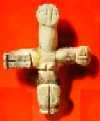 Fig.3. Idol (steatit) from Papos |
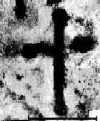 Fig.4. Cupped-cruciform facing winter solstice sun dawn |
|
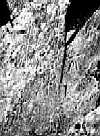 Fig.5. Anthropomorphs "observing winter solstice", at La Gardette |
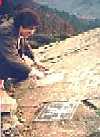 Fig.6. Tactigraphy of a "male observer", at La Gardette |
|
 Fig.7. Winter solstice shadow at Machu Picchu |
 Fig.8. Newgrange roof-box |
|
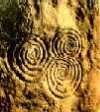 Fig.9. Newgrange's "patriarchal family triangle" |
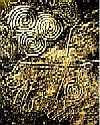 Fig.10. A patriarchal triangle in Tassili N Ajjer ? |
|
 Fig.11. South pointing summer marker at Mount Bégo |
 Fig.12. Summer marker at Fajada Butte |
|
 Fig.13. Astral Counting Device, at Xihuingo |
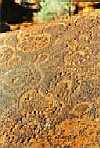 Fig.14. The moon year calendar, at Twyfelfontein |
|
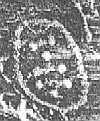 Fig.15. Camunian 8 year calendar (with intercalary moon cycles) |
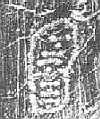 Fig.16. The octaedris watcher's shoeprint, at Foppe di Nadro |
|
 Fig.17. "Paradigm Bridging" at Søtetorp (Tactigraphy) |
 Fig.18. "Winter footprint", at Järrestad |
|
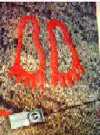 Fig.19. "Summer footprint", at Litsleby |
 Fig.20. "Summer shoeprint", at Grimentz |
|
 Fig.21. "Displaced" Summer shoeprints, at Grimentz |
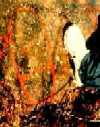 Fig.22. Giant shoeprint vs. K. Sognnes', at Lerfall |
|
 Fig.23. Decorated shoeprint vs. V. Dubal' , at Zurla |
 Fig.24. When the sun shines …behind Piz Badile |